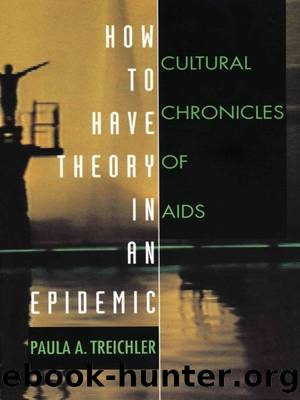How to Have Theory in an Epidemic: Cultural Chronicles of AIDS (Series Q) by Paula A. Treichler

Author:Paula A. Treichler [Treichler, Paula A.]
Language: eng
Format: epub
Publisher: Duke University Press
Published: 2012-05-31T21:00:00+00:00
Education, Prevention, and Community: Who Are the “We”? These ambiguous reports and contradictory representations have made it difficult to conceptualize communities or cohorts of “women at risk” and have discouraged the formation, among women, of a collective female identity–a “we”–around the issue of AIDS. Virtually none encourage women to feel concerned about themselves. Thus, as I noted, most women find that they “have AIDS” and thus have been at risk only when they experience Symptoms and are diagnosed; most men, in contrast, seek a diagnosis because they already know that they are at risk.21 Official prevention campaigns have still failed to find appropriate forms of address for meaningful groups of women at risk, consistently to distinguish “risk groups” (who) from “risk behaviors” (how), to create a consistent set of representations, and to place issues of AIDS and HIV within larger social, cultural, and political contexts. Except for a small number of projects and organizations that targeted education and prevention for women (Project Aware, the San Francisco AIDS Foundation, and others), women essentially heard nothing in the media or from their government until 1988, when Koop’s mailer was sent to U.S. households (see chap. 2 above).
Meanwhile, the first wave of euphemisms, like exchange of body fluids, was giving way to terms and concepts that AIDS researchers originally worked hard to clarify but that now, for official prevention purposes, are deliberately muddied. Hence, promiscuity is now used not unthinkingly but deliberately, precisely because it is pejorative; the AIDS virus is used precisely because it collapses the long period of HIV infection (whose length is uncertain and effects often invisible) with the specter and all the terrifying connotations of AIDS; promiscuity and drug addiction are labeled as intrinsically risky precisely to avoid the politically volatile burden of providing information about safer sex and cleaner needles. This package of terms has been well marketed. Surveys show that multiple partners and promiscuity per se are now associated in the public mind with an increased risk of HIV transmission and that monogamy is believed to decrease risk–whether or not the partner is infected or safer sex is practiced. At the same time, a research team found that not everyone had an adequate understanding of these terms: an adolescent woman in a focus group defined monogamy to mean sleeping with only one sexual partner at a time, not with only one sexual partner over a period of time. And a Planned Parenthood survey asked, “Are you presently sexually active?” a bread-and-butter question the organization thought it could count on. “No,” wrote one young woman in response, “I just lie there.”
Download
This site does not store any files on its server. We only index and link to content provided by other sites. Please contact the content providers to delete copyright contents if any and email us, we'll remove relevant links or contents immediately.
| African-American Studies | Asian American Studies |
| Disabled | Ethnic Studies |
| Hispanic American Studies | LGBT |
| Minority Studies | Native American Studies |
Cecilia; Or, Memoirs of an Heiress — Volume 1 by Fanny Burney(32503)
Cecilia; Or, Memoirs of an Heiress — Volume 2 by Fanny Burney(31913)
Cecilia; Or, Memoirs of an Heiress — Volume 3 by Fanny Burney(31898)
The Great Music City by Andrea Baker(31759)
We're Going to Need More Wine by Gabrielle Union(19004)
All the Missing Girls by Megan Miranda(15785)
Pimp by Iceberg Slim(14438)
Bombshells: Glamour Girls of a Lifetime by Sullivan Steve(14024)
For the Love of Europe by Rick Steves(13627)
Talking to Strangers by Malcolm Gladwell(13297)
Norse Mythology by Gaiman Neil(13281)
Fifty Shades Freed by E L James(13189)
Mindhunter: Inside the FBI's Elite Serial Crime Unit by John E. Douglas & Mark Olshaker(9266)
Crazy Rich Asians by Kevin Kwan(9224)
The Lost Art of Listening by Michael P. Nichols(7456)
Enlightenment Now: The Case for Reason, Science, Humanism, and Progress by Steven Pinker(7274)
The Four Agreements by Don Miguel Ruiz(6704)
Bad Blood by John Carreyrou(6584)
Weapons of Math Destruction by Cathy O'Neil(6220)
